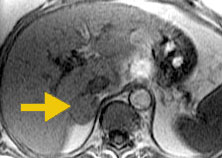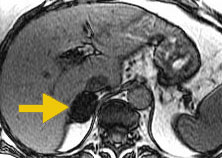Fast
MultiPlanar
Spoiled GRadient
echo (FMPSPGR)
or Dual Fast Field Echo
A 2-dimensional multi-section spoiled gradient
echo technique. Spoiling provides T1-weighting. Typically, TR is more than
100 msec, or as high as breathholding will allow (but always less than 500
msec to provide heavy T1-weighting). Flip angle is usually 60-90 degrees,
but is reduced if TR is less than 100 msec.
For greatest efficiency, TE is often minimum. For optimal
fat-water opposed-phase effect, TE should be close to 2.3 msec. For optimal
in-phase effect, TE should be 4.6 msec, although 4.2 msec is adequate.
Best results for in-phase and opposed phase imaging used dual
gradient echo technique, where two gradient echoes are obtained after each
excitation, with 2.3 msec and 4.6 msec TEs.
 |
 |
|
In-phase spoiled gradient echo image with TR/TE =
120/4.2. Arrow indicates adrenal adenoma that is isointense with liver,
both of which have much higher signal intensity than spleen.
|
Opposed-phase spoiled gradient echo image with TR/TE
= 120/2.1. The cancellation of signals from water and fat within the
adenoma has caused the signal intensity to reduce. Notice that the liver
has signal intensity more similar to that of spleen compared the in-phase
image at left, indicating mild fatty infiltration.
|
Copyright © Thomas Jefferson University. All Rights Reserved.
The Thomas Jefferson University web site, its contents and programs, is provided for informational and educational purposes only and is not intended as medical advice nor is it intended to create any physician-patient relationship. Please remember that this information should not substitute for a visit or a consultation with a health care provider. The views or opinions expressed in the resources provided do not necessarily reflect those of Thomas Jefferson University, Thomas Jefferson University Hospital, or the Jefferson Health System or staff.